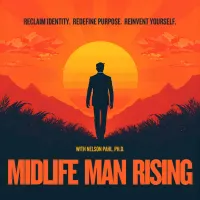
·S1 E2
Men After 50: Sensory Mapping to Calm Midlife Angst (Mini-Course - Part 2)
Episode Transcript
In the midst of midlife's quiet storm, it's easy to feel trapped in your head. Thoughts racing, memories tugging, future hazy.
But there is a way back. A way to reconnect with your body, your moment, your reality.
It's called Sensory Mapping.
I'm Nelson Pahl, an experiential psychologist that makes it easy for midlife men to reclaim identity and reinvent themselves.
And this is part two of the Good Grief John Doe mini-course.
Sensory mapping is a practice that blends journaling with a focus on your five senses: sight, sound, touch, taste, and smell.
It uses these details to bring your experience vividly into the present.
Instead of just naming an emotion, you show it. Instead of saying, "I'm anxious," you describe the tightness in your chest, the buzzing in your ears, the cold sweat on your palms.
This deeper, richer expression helps you understand yourself, what you're really feeling, and where it lives in your body.
How sensory mapping helps you.
1. It heightens your self-awareness.
2. It helps you recall feelings with clarity.
3. It helps you discover hidden triggers.
4. It helps you express yourself with more depth.
Sensory mapping turns a vague, swirling feeling into something you can see, touch, and name.
And once named, this feeling loses some of its power over you.
Here's how you can start sensory mapping today.
1. Engage your senses intentionally. During a quiet moment, eating, walking, sitting, ask yourself, what do I see? What sounds fill the space around me? What does the air feel like on my skin? What's this moment taste like? What's it smell like?
2. Describe what you notice in your journal. Don't just write, I'm sad. Instead try, a heavy weight sits low in my chest like a stone pushing down. Or, the hum of distant traffic feels like a restless buzzing in my mind.
3. Use your senses to tell a story about your day or your mood. For example, the garden outside bursts with fiery reds and yellows, and the scent of wet earth reminds me of childhood summers.
This practice grounds you in your body and your environment. It creates a clear, vivid narrative that lets you observe, without judgment, what's happening inside you.
Remember, the goal is to show, not to tell. Use sensory details to illustrate emotion. This is where the power lies. Not in simplification, but in articulation.
For example, here's a somatic exercise that I carried out here in midlife the day I finally discovered I no longer had to live by my dad's expectations of me.
Instead of saying, "I'm angry," I described it this way: "My fists clench, my jaw tightens, and my teeth grate as the latent rage rises."
Sensory mapping isn't about writing a novel. It's about telling your truth simply, clearly, and vividly.
And please, don't discard this tactic as just some woo-woo or nonsense.
This exercise can be potent.
So try it a few times. I dare you.
In the process, notice how your awareness deepens and how your story unfolds.
If this practice has opened a door for you, if you're ready to step fully into a richer, clearer understanding of yourself, then you're ready for the deeper work in my 28-day challenge, Resurrection Camp. There, we'll keep building presence, awareness, and purpose together.
I invite you to enroll at Resurrection.Camp. You'll find that link in the show notes of this podcast.
Until next time.